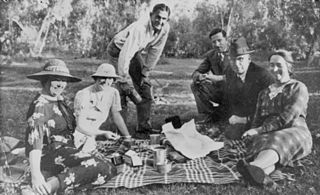
The Australia and New Zealand Banking Group Limited, commonly known as ANZ Bank, is a multinational banking and financial services company headquartered in Melbourne, Victoria, Australia. It is Australia's second-largest bank by assets and fourth-largest bank by market capitalisation.

The Bank of New South Wales (BNSW), also known as The Wales, was the first bank in Australia. It was established in 1817 in Sydney. During the 19th century, the bank opened branches throughout Australia and New Zealand, expanding into Oceania in the 20th century. Throughout it history it merged with and purchased many other financial institutions. In 1981 it merged with the Commercial Bank of Australia and was renamed Westpac on 4 May 1982.

Anthony Hordern & Sons was a major department store in Sydney, New South Wales, Australia. With 52 acres of retail space, Anthony Hordern's was once the largest department store in the world. The historic Anthony Hordern building, which was located on a block bounded by George Street, Liverpool, Pitt and Goulburn Streets, on what was a small hill called Brickfield Hill in the Sydney central business district, was controversially demolished in 1986, to make way for the World Square development.
The 1893 banking crisis in the Australian colonies involved the collapse of a considerable number of commercial banks and building societies, and a general economic depression. It occurred at the same time as the US Panic of 1893 (1893–1897).

The Bank of Australasia was an Australian bank in operation from 1835 to 1951.

The Colonial Bank of Australasia was a bank operating primarily in the Australian colony and then state of Victoria from 1856 to 1918.

The Sydney County Council (SCC) was a county council established in 1935 to produce electricity and operate the electricity network in a number of municipalities in metropolitan Sydney. While other New South Wales county councils, were formed by proclamation of the Governor, Sydney County Council was established directly by the Gas and Electricity Act 1935; despite the unusual procedure for its establishment, and the fact that special legislative provisions applied to it, it was legally classified as a county council under the same legislation which applied to all other county councils, the Local Government Act 1919. On its establishment it assumed control of the Electricity Department of the Sydney City Council, which was already supplying electricity to other municipalities. In 1952, the SCC lost most its electricity generation functions to the Electricity Commission of New South Wales and retained only its distribution functions. The SCC was merged with other municipal county councils in 1990 to form Sydney Electricity.
Rev. William Allen was an English-born Australian Congregational clergyman.
The Federal Bank of Australia was established in Melbourne in 1881, and opened for business in April, 1882. Initially successful, the company expanded to New South Wales by absorbing the Sydney and Country Bank Limited in 1882. Banknotes were issued at branches in Melbourne, Sydney and Adelaide. The headquarters was in a modest building on the corner of Elizabeth and Collins Street in Melbourne.

Mates from the Murrumbidgee is a 1911 Australian silent movie. It is considered a lost film and was arguably the first Australian war film, being set during the Boer War.
MathewBuchan Jamieson, was a Scottish-born engineer in Australia, closely identified with the young town of Broken Hill, New South Wales.

Salome Jean White was the first female flying medical doctor in Australia and the world when she commenced work with the Australian Inland Mission in May 1937. She was known as the Guardian Angel of the Gulf.
Henry Anderson Howden was a Scottish-born Australian amateur golfer. He won the Victorian Golf Cup in 1896, 1897 and 1898 and the Australian Amateur in 1901.
Thomas Smith Bellair was an English actor who moved to Australia, where he had his own dramatic company before managing various hotels, finally settling in Wagga Wagga, where his family became prominent citizens.
The London Chartered Bank of Australia was an English-run Australian bank which operated from 1852 to 1921.
Henry Richard Harwood was an Australian actor and theatre manager.
Henry Osborne Jacobs was an English musician best known as an accompanist, arranger and conductor for Ada Reeve, then settled in Australia, where he had a substantial career.
The Howson family was a show-business dynasty founded in Australia, several of whose members went on to further success in America, London and Europe.
Fanny Emily Mary Hooper, known as Minnie Hooper, was an Australian dance instructor and ballet mistress. She has been credited, with Jennie Brenan and Minnie Everett, with maintaining the high standard of Australian dance and ballet in the 1920s, between the reigns of Emilia Pasta and Anna Pavlova. She had a long series of contracts with J. C. Williamson's and conducted classes at her dance studio on Pitt Street, Sydney.
Herbert Osborn Dennis was a Victorian-born Australian architect who largely practiced in Sydney and is known for his early domestic designs and for his later substantial inner city industrial buildings showcasing early modernism.











